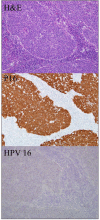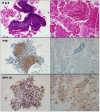Human papillomavirus and head and neck squamous cell carcinoma: recent evidence and clinical implications
- PMID: 19407148
- PMCID: PMC3317947
- DOI: 10.1177/0022034509333371
Human papillomavirus and head and neck squamous cell carcinoma: recent evidence and clinical implications
Abstract
Over the past 20 years, high-risk human papilloma-virus (HPV) infection has been established as a risk factor for developing head and neck squamous cell carcinoma, independent of tobacco and alcohol use. In particular, HPV is strongly associated with the development of oropharyngeal cancer and a small minority of oral cavity cancers. In this review, we summarize what is currently known about the biology of HPV, the mechanisms by which it effects malignant transformation, and the potential impact of HPV status on the clinical management of persons with head and neck cancer.
Figures


Similar articles
-
DETECTION OF HUMAN PAPILLOMA VIRUS IN HEAD AND NECK SQUAMOUS CELL CARCINOMAS: A LITERATURE REVIEW.Rev Med Chir Soc Med Nat Iasi. 2015 Apr-Jun;119(2):502-9. Rev Med Chir Soc Med Nat Iasi. 2015. PMID: 26204659 Review.
-
Preoperative 18F-FDG PET/CT and high-risk HPV in patients with oropharyngeal squamous cell carcinoma.Head Neck. 2014 Mar;36(3):323-7. doi: 10.1002/hed.23296. Epub 2013 Jun 1. Head Neck. 2014. PMID: 23729374
-
Human Papillomavirus and Squamous Cell Carcinoma of Unknown Primary in the Head and Neck Region: A Comprehensive Review on Clinical Implications.Viruses. 2021 Jul 2;13(7):1297. doi: 10.3390/v13071297. Viruses. 2021. PMID: 34372502 Free PMC article. Review.
-
Molecular subclassification determined by human papillomavirus and epidermal growth factor receptor status is associated with the prognosis of oropharyngeal squamous cell carcinoma.Hum Pathol. 2016 Apr;50:51-61. doi: 10.1016/j.humpath.2015.11.001. Epub 2015 Nov 17. Hum Pathol. 2016. PMID: 26997438
-
The role of human papillomavirus in oral squamous cell carcinoma (review).Georgian Med News. 2012 Dec;(213):32-6. Georgian Med News. 2012. PMID: 23293230 Review.
Cited by
-
Clinical and epidemiological characteristics of patients in the head and neck surgery department of a university hospital.Sao Paulo Med J. 2012;130(5):307-13. doi: 10.1590/s1516-31802012000500007. Sao Paulo Med J. 2012. PMID: 23174870 Free PMC article.
-
Oral and pharyngeal cancer control and early detection.J Cancer Educ. 2010 Sep;25(3):279-81. doi: 10.1007/s13187-010-0045-6. Epub 2010 Mar 5. J Cancer Educ. 2010. PMID: 20204575 Free PMC article.
-
Nutlin-3, the small-molecule inhibitor of MDM2, promotes senescence and radiosensitises laryngeal carcinoma cells harbouring wild-type p53.Br J Cancer. 2010 Jul 13;103(2):186-95. doi: 10.1038/sj.bjc.6605739. Epub 2010 Jun 29. Br J Cancer. 2010. PMID: 20588277 Free PMC article.
-
Genome-Wide Profiling of Cervical RNA-Binding Proteins Identifies Human Papillomavirus Regulation of RNASEH2A Expression by Viral E7 and E2F1.mBio. 2019 Jan 29;10(1):e02687-18. doi: 10.1128/mBio.02687-18. mBio. 2019. PMID: 30696738 Free PMC article.
-
Identification of Differentially Expressed Genes Induced by Aberrant Methylation in Oral Squamous Cell Carcinomas Using Integrated Bioinformatic Analysis.Int J Mol Sci. 2018 Jun 7;19(6):1698. doi: 10.3390/ijms19061698. Int J Mol Sci. 2018. PMID: 29875348 Free PMC article.
References
-
- Ahomadegbe JC, Barrois M, Fogel S, Le Bihan ML, Douc-Rasy S, Duvillard P, et al. (1995). High incidence of p53 alterations (mutation, deletion, overexpression) in head and neck primary tumors and metastases; absence of correlation with clinical outcome. Frequent protein overexpression in normal epithelium and in early non-invasive lesions. Oncogene 10:1217-1227 - PubMed
-
- Andrews E, Seaman WT, Webster-Cyriaque J. (2008). Oropharyngeal carcinoma in non-smokers and non-drinkers: a role for HPV. Oral Oncol (in press). - PubMed
-
- Begum S, Cao D, Gillison M, Zahurak M, Westra WH. (2005). Tissue distribution of human papillomavirus 16 DNA integration in patients with tonsillar carcinoma. Clin Cancer Res 11:5694-5699 - PubMed
-
- Begum S, Gillison ML, Nicol TL, Westra WH. (2007). Detection of human papillomavirus-16 in fine-needle aspirates to determine tumor origin in patients with metastatic squamous cell carcinoma of the head and neck. Clin Cancer Res 13:1186-1191 - PubMed
Publication types
MeSH terms
Grants and funding
LinkOut - more resources
Full Text Sources
Medical
Miscellaneous

